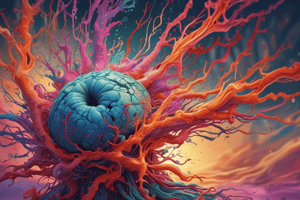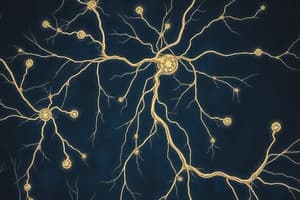Podcast
Questions and Answers
Which of the following is NOT one of the four attributes of a stimulus mediated by sensory systems?
Which of the following is NOT one of the four attributes of a stimulus mediated by sensory systems?
- Modality
- Intensity
- Emotion (correct)
- Location
What is the ultimate purpose of various sensory receptors, despite their different morphologies and organizations?
What is the ultimate purpose of various sensory receptors, despite their different morphologies and organizations?
- To transduce stimulus energy into electrochemical energy (correct)
- To amplify external stimuli
- To maintain homeostasis
- To protect the body from harmful stimuli
How is stimulus intensity primarily encoded by neurons?
How is stimulus intensity primarily encoded by neurons?
- By the frequency of action potentials (correct)
- By the type of neurotransmitter released
- By the duration of the receptor potential
- By the amplitude of the action potentials
What is the role of rapidly adapting mechanoreceptors in sensory perception?
What is the role of rapidly adapting mechanoreceptors in sensory perception?
What is a receptive field in the context of sensory neurons?
What is a receptive field in the context of sensory neurons?
In the olfactory epithelium, which cell type is responsible for the transduction of odorant molecules?
In the olfactory epithelium, which cell type is responsible for the transduction of odorant molecules?
What is the primary role of odorant-binding proteins in olfactory transduction?
What is the primary role of odorant-binding proteins in olfactory transduction?
What is the effect of cAMP production in olfactory transduction?
What is the effect of cAMP production in olfactory transduction?
Within the olfactory bulb, where do the olfactory receptor neurons synapse?
Within the olfactory bulb, where do the olfactory receptor neurons synapse?
Which of the following is a symptom of damage to the olfactory bulb?
Which of the following is a symptom of damage to the olfactory bulb?
Which cranial nerve does NOT transmit taste information from the tongue?
Which cranial nerve does NOT transmit taste information from the tongue?
Where are taste receptor cells located?
Where are taste receptor cells located?
What is the function of the taste pore?
What is the function of the taste pore?
Which area of the tongue is MOST sensitive to sweet tastes?
Which area of the tongue is MOST sensitive to sweet tastes?
How do sour stimuli affect taste receptor cells?
How do sour stimuli affect taste receptor cells?
What is the role of the solitary nucleus in taste pathways?
What is the role of the solitary nucleus in taste pathways?
Where does the VPMpc (parvicellular division of the ventral posteromedial nucleus) of the thalamus project to?
Where does the VPMpc (parvicellular division of the ventral posteromedial nucleus) of the thalamus project to?
Which clinical condition results in a loss of taste sensation?
Which clinical condition results in a loss of taste sensation?
Where is the location of the anterior cortical amygdaloid nucleus?
Where is the location of the anterior cortical amygdaloid nucleus?
What is the lateral posterior orbitofrontal cortex thought to be involved in?
What is the lateral posterior orbitofrontal cortex thought to be involved in?
What is the olfactory nerve also known as?
What is the olfactory nerve also known as?
Which of the following cell types is NOT found in the olfactory epithelium?
Which of the following cell types is NOT found in the olfactory epithelium?
What is the primary function of basal cells in the olfactory epithelium?
What is the primary function of basal cells in the olfactory epithelium?
In the context of intensity and duration, what does a frequency code refer to?
In the context of intensity and duration, what does a frequency code refer to?
After transduction in olfactory receptor neurons, where is the next location where olfactory information is processed?
After transduction in olfactory receptor neurons, where is the next location where olfactory information is processed?
What term is used to describe distorted smell sensations?
What term is used to describe distorted smell sensations?
Which of the following is NOT a layer of the olfactory bulb?
Which of the following is NOT a layer of the olfactory bulb?
Which brain area receives direct projections from the olfactory bulb?
Which brain area receives direct projections from the olfactory bulb?
In patients with uncinate fits, which brain structure is most likely affected?
In patients with uncinate fits, which brain structure is most likely affected?
In taste receptor cells, second messengers like inositol triphosphate (IP3) typically trigger what downstream effect?
In taste receptor cells, second messengers like inositol triphosphate (IP3) typically trigger what downstream effect?
What type of papillae does NOT contain taste buds?
What type of papillae does NOT contain taste buds?
Taste receptor cells have a life span of:
Taste receptor cells have a life span of:
In the olfactory system, what type of cell undergoes continuous turnover?
In the olfactory system, what type of cell undergoes continuous turnover?
If a patient reports experiencing phantosmia after a head injury, which brain area is likely damaged?
If a patient reports experiencing phantosmia after a head injury, which brain area is likely damaged?
Flashcards
Four stimulus attributes
Four stimulus attributes
Sensory systems encode four attributes of a stimulus: modality, intensity, duration, and location.
Modality definition
Modality definition
The type of stimulus or sensation it represents, such as touch, sight, or sound.
Intensity definition
Intensity definition
The strength or magnitude of a stimulus.
Duration definition
Duration definition
Signup and view all the flashcards
Location definition
Location definition
Signup and view all the flashcards
Sensory Transduction
Sensory Transduction
Signup and view all the flashcards
Frequency Code
Frequency Code
Signup and view all the flashcards
Receptive Field
Receptive Field
Signup and view all the flashcards
Olfactory Mucosa
Olfactory Mucosa
Signup and view all the flashcards
Olfactory Epithelium Cells
Olfactory Epithelium Cells
Signup and view all the flashcards
Olfactory Neuron Structure
Olfactory Neuron Structure
Signup and view all the flashcards
Olfactory Fila
Olfactory Fila
Signup and view all the flashcards
Olfactory Bulb Layers
Olfactory Bulb Layers
Signup and view all the flashcards
Olfactory Glomerulus
Olfactory Glomerulus
Signup and view all the flashcards
Efferent Olfactory Projections
Efferent Olfactory Projections
Signup and view all the flashcards
Olfactory Cortex Connections
Olfactory Cortex Connections
Signup and view all the flashcards
Anosmia/Hyposmia
Anosmia/Hyposmia
Signup and view all the flashcards
Cacosmia
Cacosmia
Signup and view all the flashcards
Taste Receptor Cells
Taste Receptor Cells
Signup and view all the flashcards
Taste Pore
Taste Pore
Signup and view all the flashcards
Taste Bud locations
Taste Bud locations
Signup and view all the flashcards
Papillae and Taste
Papillae and Taste
Signup and view all the flashcards
Fungiform/filiform papillae
Fungiform/filiform papillae
Signup and view all the flashcards
Circumvallate papillae location
Circumvallate papillae location
Signup and view all the flashcards
Foliate papillae shape
Foliate papillae shape
Signup and view all the flashcards
Tongue Taste Areas
Tongue Taste Areas
Signup and view all the flashcards
Taste Reception Process
Taste Reception Process
Signup and view all the flashcards
Salt Stimuli
Salt Stimuli
Signup and view all the flashcards
Sour Taste Stimuli and Channels
Sour Taste Stimuli and Channels
Signup and view all the flashcards
Sweet/Bitter/Amino Acids
Sweet/Bitter/Amino Acids
Signup and view all the flashcards
Taste Nerves
Taste Nerves
Signup and view all the flashcards
Facial Nerve Taste fibres
Facial Nerve Taste fibres
Signup and view all the flashcards
IX Nerve Taste Fibers
IX Nerve Taste Fibers
Signup and view all the flashcards
Vagus Nerve Taste Fibers
Vagus Nerve Taste Fibers
Signup and view all the flashcards
Taste Fiber Termination
Taste Fiber Termination
Signup and view all the flashcards
Study Notes
Sensory Systems and Stimulus Attributes
- Sensory systems encode four attributes of a stimulus: modality, intensity, duration, and location.
Modality
- Sensory receptors transduce stimulus energy into electrochemical energy.
- Sensory receptors translate stimulus features into neural codes.
- Sensory transduction produces a receptor, also known as a generator, potential.
- Different types of stimulus energies utilize different molecular mechanisms.
Intensity
- Stimulus information is transmitted to the CNS by conducted action potentials.
- Different regions of a primary afferent fiber have different physiological characteristics.
- Receptor, or generator, potentials interact with the spike-generating membrane.
- A graded signal is converted into an all-or-none signal via frequency code.
- A slowly adapting mechanoreceptor increases firing rate as stimulus intensity increases and stops firing when the stimulus ends, indicating duration.
- A rapidly adapting mechanoreceptor neuron only fires when the stimulus is changing, with an off response signaling stimulus change.
Location
- Sensory receptors and neurons in the central nervous system have a receptive field.
- Each primary sensory neuron has a receptive field.
- Central neurons receive information from many primary receptor neurons and have a larger receptive field.
Olfactory Receptors: Location and Structure
- Olfactory receptors are located in the olfactory mucosa in the roof of the nasal cavity.
- The olfactory mucosa has three layers: an acellular layer of mucus, the olfactory epithelium layer, and the lamina propria.
- The olfactory epithelium contains olfactory receptor neurons, supporting cells or sustencular cells, and basal cells.
- Olfactory receptor neurons have a single apical dendrite and a thin basal axon.
- The dendrite terminates in a bulbous olfactory knob with 10 to 30 nonmotile cilia.
Olfactory Nerve
- Small unmyelinated axons pass through the basal lamina and the cribriform plate, grouping together to form olfactory fila.
- These olfactory fila collectively form the olfactory nerve (I).
- Olfactory receptors are neurons that undergo continuous turnover every 30 to 60 days.
Olfactory Transduction
- Odorants pass through the mucus layer to reach the cilia of the olfactory receptor neurons.
- Hydrophobic odorants are assisted by odorant binding proteins.
- Odorant receptors are coupled to olfactory specific G-proteins.
- G-proteins produce an increase in cAMP and activation of cation channels, resulting in a generator potential.
Central Olfactory Pathways
- The olfactory bulb is located on the ventral surface of the frontal lobe.
- The olfactory bulb consists of five layers: the olfactory nerve, glomerular layer, external plexiform layer, mitral cell layer, and granule cell layer.
- The olfactory glomerulus consists of branching terminals of olfactory receptors that synapse with the bushy endings of mitral and tufted cells.
- The mitral and tufted cell axons form the output of the bulb.
- The glomerulus receives centrifugal projections from the CNS, specifically NE and 5HT.
Efferent Projections
- Efferent projections from the olfactory bulb project to the olfactory cortex, which is paleocortex and has three layers.
- The layers include the olfactory tubercle, piriform cortex, anterior cortical amygdaloid nucleus, periamygdaloid cortex, and lateral entorhinal cortex.
- Olfactory cortex cells have reciprocal interactions with other regions of the olfactory cortex through intrinsic, or associational, connections.
- Extrinsic connections include projections back to the olfactory bulb.
- A direct projection exists to the insular and orbital neocortex, and an indirect pathway exists through the dorsomedial nucleus of the thalamus.
- Projects to the hypothalamus for feeding and the hippocampus for memory
Clinical Conditions Affecting Olfactory Sensation
- Head trauma can cause the olfactory bulb to move with respect to the cribriform plate, damaging the axons projecting from sensory neurons to the olfactory bulb, resulting in anosmia, which is the loss of function, or hyposmia, a reduction of function.
- Both can also result from damage to the olfactory mucosa due to infections.
- Loss or alteration of olfactory function may occur in Alzheimer's and Parkinson's diseases.
- Seizure activity in the temporal lobe can produce olfactory hallucinations of unpleasant smells or cacosmia and is referred to as an uncinate fit.
- The structures affected include the uncus, parahippocampal gyrus, amygdala, and piriform and entorhinal cortices.
Taste Receptors: Location and Structure
- Taste receptor cells are located in taste buds.
- Each taste bud contains 40 to 60 taste receptor cells.
- Taste cells extend from the basal lamina to the taste pore, which is covered with microvilli.
- Taste receptor cells have a lifespan of 10 to 14 days and new ones arise from basal cells.
- Afferent fibers penetrate the basement membrane and are postsynaptic to the taste receptor cells.
Taste Buds and Papillae
- Taste buds are found on the human tongue, palate, pharynx, and larynx.
- On the tongue, taste buds are found in specialized structures called papillae.
- On the anterior two-thirds of the tongue, taste buds are found in fungiform and filiform papillae.
- Circumvallate papillae are located in a V-like structure at the back of the tongue.
- Foliate papillae are short vertical folds located on each side of the tongue.
- Areas of the tongue are more sensitive to specific tastes, with sweet at the tip, bitter at the back, and sour and salt on the sides.
Taste Transduction
- Soluble chemicals diffuse through the taste pore to interact with receptors on the microvilli of the receptor cells.
- Salt stimuli activate sodium channels.
- Transmitter is released in the basolateral membrane to depolarize the afferent fibers.
- Sour stimuli, or protons, close potassium channels.
- Sweet, bitter, and amino acid stimuli interact with G-protein coupled receptors.
- Bitter and amino acid stimuli raise inositol triphosphate concentration, causing calcium release from intracellular stores.
- Transmitter is released in the basolateral membrane in both scenarios to depolarize afferent fibers.
Peripheral Taste Pathways
- Afferent axons from taste buds travel in the facial (VII), glossopharyngeal (IX), and vagus nerves, which are special visceral afferents.
- Facial nerve taste fibers have cell bodies located in the geniculate ganglion and innervate taste buds on the anterior two-thirds of the tongue and soft palate.
- Glossopharyngeal nerve taste fibers innervate taste buds located in the vallate papillae and posterior parts of the foliate papillae via the lingual-tonsillar branch, and the cell bodies are in the petrosal ganglion.
- Vagus nerve taste fibers innervate taste buds on the epiglottis and esophagus via the superior laryngeal branch, with cell bodies in the nodose ganglion.
- Central processes enter the brainstem as part of their respective nerves, join the solitary tract, and project caudally to terminate on cells in the solitary nucleus.
Central Taste Pathways
- Taste fibers terminate in the rostral or gustatory solitary nucleus.
- Axons from secondary taste cells ascend in the solitario-thalamic tract.
- The tract terminates in the parvicellular division of the ventral posteromedial nucleus of the thalamus or VPMpc.
- Axons of the VPMpc cells project to the primary gustatory cortex in the insula and operculum.
Clinical Conditions Affecting Taste Sensation
- Damage to the nerves innervating taste buds causes total ageusia, or the loss of all taste sensation, partial ageusia, the loss of a particular taste sensation, or hypoageusia, the decreased sensation of taste. It depends on the extent of damage.
Summary of Olfaction and Taste
- There is a structural and functional understanding of olfactory receptors and transduction mechanisms, along with the central olfactory pathways.
- Also, a structural and functional understanding of taste receptors and transduction mechanisms, with taste central pathways.
- The systems are united in the lateral posterior orbitofrontal cortex, a site of integration of taste, olfactory, and visual cues, thought to be involved in flavor appreciation, food reward, and feeding control.
Studying That Suits You
Use AI to generate personalized quizzes and flashcards to suit your learning preferences.




